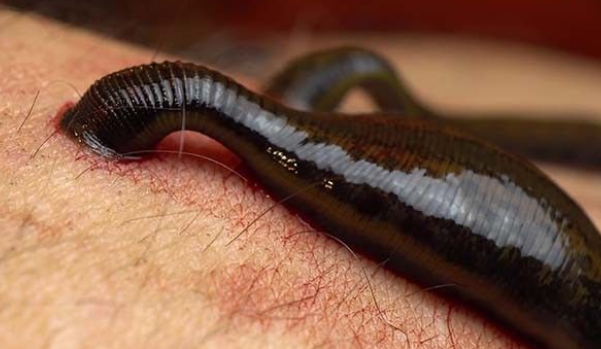I can’t tell you how disgusting these creatures are to me. And now, as we settle into a good weekend to relax…
White men can’t jump, but terrestrial leeches can. This surprising fact was confirmed after centuries of anecdotal reports when these parasites were caught on video leaping from leaves in the Madagascan rainforest. The footage was first captured in 2017 by Mai Fahmy, a researcher currently at the American Museum of Natural History. Fahmy encountered a leech exhibiting “questing” behavior, where it extends its body to find a host, in Madagascar’s Ranomafana National Park.
Video shows leeches jumping from leaf to leaf in groundbreaking discovery https://t.co/MNdc5dY0yk
— USA TODAY Tech (@usatodaytech) June 21, 2024
Fahmy recorded the leech inching forward before springing off a leaf and landing on the forest floor. This remarkable footage, along with another video from 2023 showcasing the leeches’ acrobatics, was published in Biotropica. Fahmy stated that even though she was in Madagascar collecting leeches for bloodmeal analysis, there was significant pressure to capture more video evidence to support their research claims. The team’s work validates the longstanding anecdotal evidence that terrestrial leeches, specifically the species Chtonobdella fallax, do leap in search of a host.
Jumping leeches have been documented as far back as the 14th century by the famous explorer Ibn Battuta, who observed this behavior in leeches in Sri Lanka. This suggests that the leaping ability may have evolved independently in various terrestrial leech species. However, by the mid-20th century, scientific publications began to view the notion of jumping leeches with skepticism.
Leaping leeches!!
First convincing video evidence that at least one species of terrestrial leech can jump, behavior that scientists have debated for more than a century.
(AMNH/Fordham/CUNY)https://t.co/5d4Vr8G4mW— Steven Ashley (@steveashleyplus) June 20, 2024
Michael Tessler, an invertebrate zoologist at the American Museum of Natural History and Medger Evers College, explained that the skepticism revolved around the definition of a “jump.” Despite observations from well-trained naturalists over centuries, it wasn’t until serious studies of leeches began in the 1800s and early 1900s that many biologists concluded leeches couldn’t jump.
While it was known that leeches sometimes fall onto their hosts, the debate was about whether they intentionally launch themselves or simply topple off. The video evidence now shows that leeches coil up and spring forward intentionally, suggesting they expend energy to leap towards potential hosts. This behavior likely occurs after they detect motion or heat from a host, making it a leap of faith in their search for a meal.
Fahmy has experienced leech bites multiple times, including an instance where one landed in her eye. She noted that leeches often target the eyes. When captured, the bloodmeals of these leeches can be analyzed to understand the rainforest’s biodiversity, as leeches essentially serve as mobile environmental DNA labs.
•Videos released by researchers appear to give the first concrete evidence of land-dwelling leeches jumping.
•The leeches “coil back” before springing upward to jump off leaves and onto the jungle floor in Madagascar.
— Andy_Weeble_Weaver💙⚫🌻🦋🦡🐿️🌍🗿≠𝕏 (@AndrewW66619812) June 21, 2024
Fahmy expressed her commitment to returning to Madagascar to continue her research on leeches. She emphasized the vast unknowns regarding their biology, natural history, and behaviors, noting that these creatures are still full of mystery.
Key Points:
i. Terrestrial leeches have been confirmed to jump from leaves in search of hosts, based on video evidence captured in the Madagascan rainforest.
ii. Mai Fahmy, a researcher from the American Museum of Natural History, first recorded this behavior in 2017 during a study in Madagascar’s Ranomafana National Park.
iii. The footage shows leeches coiling and springing off leaves, validating anecdotal reports and historical observations dating back to the 14th century.
iv. The research, published in Biotropica, argues that leeches intentionally leap towards potential hosts after detecting motion or heat.
v. Fahmy plans to continue studying leeches in Madagascar, emphasizing the many unknowns about their biology and behavior, and highlighting their role as mobile environmental DNA labs.
Fallon Jacobson – Reprinted with permission of Whatfinger News



